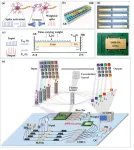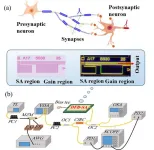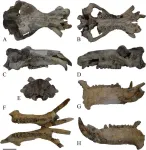(Press-News.org) EMBARGOED FOR RELEASE UNTIL 4 P.M. ET, WEDNESDAY, NOVEMBER 22, 2022
MINNEAPOLIS – Black people who eat more foods with whole grains, including some breads and cereals, quinoa, and popcorn, may have a slower rate of memory decline compared to Black people who eat fewer whole grain foods, according to a study published in the November 22, 2023, online issue of Neurology®, the medical journal of the American Academy of Neurology. The researchers did not see a similar trend in white participants.
The study does not prove that eating more whole grains slows memory decline; it only shows an association.
The study found that among Black people, those who ate the most whole grains had lower levels of memory decline—equivalent to being 8.5 years younger than those who ate small amounts of whole grains.
“With Alzheimer’s disease and dementia affecting millions of Americans, finding ways to prevent the disease is a high public health priority,” said study author Xiaoran Liu, PhD, MSc, of Rush University in Chicago. “It’s exciting to see that people could potentially lower their risk of dementia by increasing their diet of whole grains by a couple of servings a day.”
The study involved 3,326 people with an average age of 75 without dementia. Of all participants, 1,999 people, or 60%, were Black. They were followed for an average of six years.
They filled out a questionnaire every three years on how often they ate whole grains. They also completed cognitive and memory tests every three years, including recalling lists of words, remembering numbers and putting them in the correct order.
Participants were then divided into five groups based on the amount of whole grains they had in their diet. The lowest group consumed less than half a serving per day, and the highest group consumed 2.7 servings per day. The Dietary Guidelines for Americans recommend at least three servings of whole grain foods daily. One serving of whole grains is equivalent to an ounce of food, such as one slice of bread, a half cup of cooked pasta or rice, an ounce of crackers or a cup of dry cereal.
Researchers found that a higher proportion of Black participants had more than one serving per day of whole grains than white participants, with 67% and 38%, respectively.
To determine rates of cognitive decline, researchers used an overall global cognition score summarizing four cognitive tests and examined their change over time.
After adjusting for factors that could affect the rate of cognitive decline, such as age, sex, education and smoking, researchers found that the global cognitive score of Black people who had the highest intake of whole grains, or more than three servings a day, declined at a rate of 0.2 standard deviation units per decade more slowly than Black people who had the lowest intake, or less than one serving per day.
“These results could help medical professionals make tailored diet recommendations,” Liu added. “More large studies are needed to validate our findings and to further investigate the effect of whole grains on cognition in different racial groups.”
A limitation of the study is that the food frequency questionnaire was self-reported, so people may not accurately remember what they ate.
The study was supported by the Alzheimer's Association and the National Institutes of Health.
Learn more about dementia at BrainandLife.org, home of the American Academy of Neurology’s free patient and caregiver magazine focused on the intersection of neurologic disease and brain health. Follow Brain & Life® on Facebook, Twitter and Instagram.
When posting to social media channels about this research, we encourage you to use the hashtags #Neurology and #AANscience.
The American Academy of Neurology is the world’s largest association of neurologists and neuroscience professionals, with over 40,000 members. The AAN is dedicated to promoting the highest quality patient-centered neurologic care. A neurologist is a doctor with specialized training in diagnosing, treating and managing disorders of the brain and nervous system such as Alzheimer’s disease, stroke, migraine, multiple sclerosis, concussion, Parkinson’s disease and epilepsy.
For more information about the American Academy of Neurology, visit AAN.com or find us on Facebook, Twitter, Instagram, LinkedIn and YouTube.
END
Adding a few servings of whole grains linked to slower memory decline in Black people
2023-11-22
ELSE PRESS RELEASES FROM THIS DATE:
Researchers obtain promising results against capacity loss in vanadium batteries
2023-11-22
An article by researchers at the Center for Development of Functional Materials (CDMF) in Brazil describes a successful strategy to mitigate charge capacity loss in vanadium redox flow batteries, which are used by electric power utilities among other industries and can accumulate large amounts of energy. The article is published in the Chemical Engineering Journal.
CDMF is a Research, Innovation and Dissemination Center (RIDC) funded by FAPESP and hosted by the Federal University of São Carlos (UFSCar) in São Paulo state.
The study involved computer ...
Photonic integrated neuro-synaptic core for convolutional spiking neural network
2023-11-22
A new publication from Opto-Electronic Advances, 10.29026/oea.2023.230140 discusses photonic integrated neuro-synaptic core for convolutional spiking neural network.
Brain science and brain-like intelligence are the cutting-edge science and technology that countries all over the world compete to seize. The rapid rise and vigorous development of emerging fields such as artificial intelligence, 5G/6G, big data, autonomous driving, and the Internet of Things has led to the explosive growth of global data. Due to the memory wall effect, the conventional von Neumann architecture performs low energy efficiency. Electronic ...
Multi-synaptic photonic SNN based on a DFB-SA chip
2023-11-22
A new publication from Opto-Electronic Science; DOI 10.29026/oes.2023.230021 overviews multi-synaptic photonic SNN based on a DFB-SA chip.
Compared with traditional artificial neural networks, spiking neural networks (SNN) are more biologically authentic, more powerful, and less power-consuming due to their spatiotemporal coding and event-driven characteristics. In recent years, optical computing has been widely considered as a hardware acceleration platform, where nonlinear computing poses a challenge. Photonic SNN provides an ultra-fast and energy-efficient platform for high-performance ...
Optical trapping of optical nanoparticles: fundamentals and applications
2023-11-22
A new publication from Opto-Electronic Science; DOI 10.29026/oes.2023.230019 overviews optical trapping of optical nanoparticles.
This article reviews the fundamentals and applications of optically trapped optical nanoparticles. Optical nanoparticles are nowadays one of the key elements of photonics. They do not only allow optical imaging of a plethora of systems (from cells to microelectronics), but also behave as highly sensitive remote sensors. In recent years, it has been demonstrated the success of optical tweezers in isolating and manipulating individual optical nanoparticles. This has opened the door to high resolution single particle scanning ...
Casas del Turuñuelo, a site of repeated animal sacrifice in Iron Age Spain
2023-11-22
The Iron Age site of Casas del Turuñuelo was used repeatedly for ritualized animal sacrifice, according to a multidisciplinary study published November 22, 2023 in the open-access journal PLOS ONE by Mª Pilar Iborra Eres of the Institut Valencià de Conservació, Restauració i Investigació, Spain, Sebastián Celestino Pérez of Consejo Superior de Investigaciones Científicas, Spain, and their colleagues.
Archaeological sites with evidence of major animal sacrifices are rarely ...
Earliest known European common hippopotamus fossil reveals their Middle Pleistocene dispersal
2023-11-22
Modern hippos first dispersed in Europe during the Middle Pleistocene, according to a study published November 22, 2023 in the open-access journal PLOS ONE by Beniamino Mecozzi of the Sapienza University of Rome and colleagues.
Modern hippos, Hippopotamus amphibius, arose from African ancestors during the Quaternary, a time when hippos were widespread in Europe. However, the details of the modern species’ origin and dispersal into Europe are unclear and highly debated. In this study, Mecozzi and colleagues provide new insights via analysis of a fossil hippo skull from the study area of Tor di Quinto in Rome.
The skull of Tor di Quinto, currently housed at the ...
Status threat - the concern that outsiders will undermine your group's status - is associated with increased age, conservatism, conspiracy mentality, and paranoia, in study of 300 US adults
2023-11-22
Status threat - the concern that outsiders will undermine your group's status - is associated with increased age, conservatism, conspiracy mentality, and paranoia, in study of 300 US adults
###
Article URL: https://journals.plos.org/plosone/article?id=10.1371/journal.pone.0293930
Article Title: Conspiracy mentality, subclinical paranoia, and political conservatism are associated with perceived status threat
Author Countries: USA
Funding: The authors received no specific funding for this work. END ...
Transplanting gut microbes from an obesity-resistant shrew can improve microbiome diversity and decrease the weight of obese mice
2023-11-22
Transplanting gut microbes from an obesity-resistant shrew can improve microbiome diversity and decrease the weight of obese mice
###
Article URL: https://journals.plos.org/plosone/article?id=10.1371/journal.pone.0293213
Article Title: Gut microbiota of Suncus murinus, a naturally obesity-resistant animal, improves the ecological diversity of the gut microbiota in high-fat-diet-induced obese mice
Author Countries: Japan, China
Funding: This work (PONE-D-23-21281) was supported by a Grant-in-Aid for Scientific Research from the ...
Airborne virus infectivity can be reduced by up to 99.98% by commercially available NPBI-based air purifiers, per experiment using real-world concentrations of COVID-19 strains, flu and RSV viruses
2023-11-22
Airborne virus infectivity can be reduced by up to 99.98% by commercially available NPBI-based air purifiers, per experiment using real-world concentrations of COVID-19 strains, flu and RSV viruses
###
Article URL: https://journals.plos.org/plosone/article?id=10.1371/journal.pone.0293504
Article Title: Bipolar ionization rapidly inactivates real-world, airborne concentrations of infective respiratory viruses
Author Countries: USA
Funding: The authors received no specific funding for this work. All research and 3rd party laboratory testing was funded entirely by GPS Air. Edward Sobek is an employee of GPS Air ...
7 in 8 homicide victims in South Africa are male
2023-11-22
7 in 8 homicide victims in South Africa are male, with homicide rates peaking on weekends and holidays, and firearms and sharp items being the most common murder weapons, in analysis of almost 20,000 2017 post-mortems. END ...








